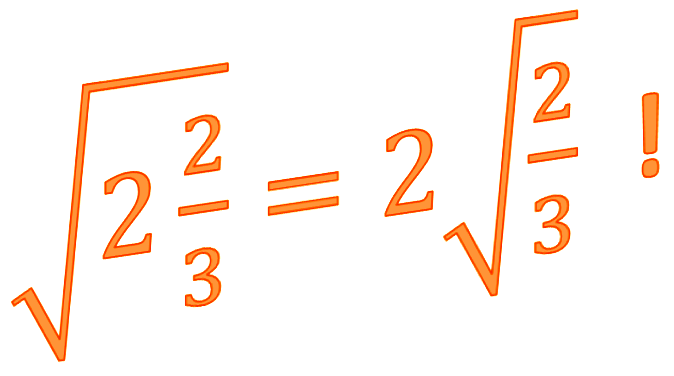ILS3.1 Simplifying surds

What happens if you want to take the root of larger surds?
These may be factorised down to numbers that may or may not be surds.
Read this sheet to see how larger surds can be factorised out and expressed as a combination of both rational numbers and surds.
A surd is an expression that cannot be expressed exactly without a square root, cube root or other root symbol. Because surds are irrational numbers, in decimal form they contain an infinite number of non-recurring digits.
Expressions like \(\sqrt{2},\) \(\sqrt{3}\), \(\frac{1}{\sqrt{8},}\), \(\sqrt{20},\) \(\sqrt[3]{10},\) \(\sqrt[4]{9},\) are all surds but \(\sqrt{1},\sqrt{9},\frac{1}{\sqrt{100},},\sqrt{25},\sqrt[3]{64},\sqrt[4]{16},\) are not because they can be written as \(1,3,0.1,5,4\) and \(2\) respectively.
More complex expressions such as \(3\sqrt{2}\) and \(\sqrt{5}-\sqrt{2}\) are also surds.
Simplifying Surds
Rules for simplifying surds
\(\sqrt{a\times b}=\sqrt{a}\times\sqrt{b}\)
\(\sqrt{\frac{a}{b}}=\frac{\sqrt{a}}{\sqrt{b}}\)
If a square root surd has a square factor greater than \(1,\) that is, \(4,9,16,25,36...\) then it can be simplified. Similarly if a cube root surd has a cube factor greater than \(1,\) that is, \(8,27,64,125,\ldots\), then it can be simplified.
Examples
Simplify \(\sqrt{200}.\) \[\begin{align*} \sqrt{200} & =\sqrt{100\times2}\ \textrm{(factorize out the square factor)}\\ & =\sqrt{100}\times\sqrt{2}\ \textrm{(using Rule 1)}\\ & =10\sqrt{2}. \end{align*}\]
Simplify \(\frac{\sqrt[3]{24}}{2}\). \[\begin{align*} \frac{\sqrt[3]{24}}{2} & =\frac{\sqrt[3]{8\times3}\ }{2}\textrm{(factorize out the cube factor)}\\ & =\frac{\sqrt[3]{8}\times\sqrt[3]{3}}{2}\ \textrm{(using Rule 1)}\\ & =\frac{2\sqrt[3]{3}}{2}\\ & =\sqrt[3]{3}. \end{align*}\]
Addition and Subtraction of Surds
Only like surds can be added or subtracted.
Examples
Simplify \(8\sqrt{5}-3\sqrt{5}\). \[\begin{align*} 8\sqrt{5}-3\sqrt{5} & =5\sqrt{5}\;\;\textrm{(just as $8x-5x=5x$ .)} \end{align*}\]
Simplify \(2\sqrt{3}+5\sqrt{7}-10\sqrt{3}\). \[\begin{align*} 2\sqrt{3}+5\sqrt{7}-10\sqrt{3} & =5\sqrt{7}-8\sqrt{3}\;\;(\textrm{just as $2x+5y-10x=5y-8x.)$ } \end{align*}\]
Simplify \(\sqrt{18}-\sqrt{8}-\sqrt{20}\) \[\begin{align*} \sqrt{18}-\sqrt{8}-\sqrt{20} & =\sqrt{9\times2}-\sqrt{4\times2}-\sqrt{4\times5}\\ & =3\sqrt{2}-2\sqrt{2}-2\sqrt{5}\\ & =\sqrt{2}-2\sqrt{5}. \end{align*}\] Note that \(\sqrt{2}-2\sqrt{5}\) cannot be simplified because \(\sqrt{2}\) and \(\sqrt{5}\) are not like surds.
Multiplication of Surds
The following rule can be used to multiply terms containing surds:
\[\begin{align*} a\sqrt{b}\times c\sqrt{d} & =ac\sqrt{bd}. \end{align*}\]
Examples
Simplify \(\sqrt{2}\times\sqrt{3}.\) \[\begin{align*} \sqrt{2}\times\sqrt{3} & =\sqrt{6}. \end{align*}\]
Simplify \(3\sqrt{3}\times4\sqrt{5}\). \[\begin{align*} 3\sqrt{3}\times4\sqrt{5} & =12\sqrt{15}. \end{align*}\]
Simplify \(2\sqrt{10}\times7\sqrt{6}\). \[\begin{align*} 2\sqrt{10}\times7\sqrt{6} & =14\sqrt{60}\ \ (\textrm{which can be simplified further)}\\ & =14\sqrt{4\times15}\\ & =14\times2\sqrt{15}\\ & =28\sqrt{15} \end{align*}\]
Division of Surds
The rule \(\frac{\sqrt{a}}{\sqrt{b}}=\sqrt{\frac{a}{b}}\) may helpful in simplifying fractions that contain surds.
Examples
\(\frac{\sqrt{18}}{\sqrt{6}}=\sqrt{\frac{18}{6}}=\sqrt{3}\).
\(\frac{4}{\sqrt{2}}=\frac{\sqrt{16}}{\sqrt{2}}=\sqrt{\frac{16}{2}}=\sqrt{8}=\) \(\sqrt{2\times4}=2\sqrt{2}\).
Expansion of Brackets
The usual algebraic rules for removing brackets apply to brackets containing surds
\(a\left(b+c\right)=ab+ac\)
\(\left(a+b\right)\left(c+d\right)=ac+bc+ad+bd\).
Examples
Simplify \(\sqrt{2}(\sqrt{2}+5)\). \[\begin{align*} \sqrt{2}(\sqrt{2}+5) & =2+5\sqrt{2} \end{align*}\]
Simplify \(\left(\sqrt{6}-4\sqrt{3})\right)\left(2\sqrt{2}-3\sqrt{5}\right)\).
\[\begin{align*} \left(\sqrt{6}-4\sqrt{3}\right)\left(2\sqrt{2}-3\sqrt{5}\right) & =2\sqrt{12}-8\sqrt{6}-3\sqrt{30}+12\sqrt{15}\\ & =2\sqrt{4\times3}-8\sqrt{6}-3\sqrt{30}+12\sqrt{15}\\ & =2\times2\times\sqrt{3}-8\sqrt{6}-3\sqrt{30}+12\sqrt{15}\\ & =4\sqrt{3}-8\sqrt{6}-3\sqrt{30}+12\sqrt{15} \end{align*}\]
Rationalizing Denominators
Sometimes fractions containing surds are required to be expressed with a rational denominator.
Examples
Rationalize the denominator of \(\frac{2}{\sqrt{5}}.\) 1 Note that \[\begin{align*} \frac{\sqrt{5}}{\sqrt{5}} & =1 \end{align*}\] and so multiplication by \(\sqrt{5}/\sqrt{5}\) does not change the value of \(2/\sqrt{5}\). \[\begin{align*} \frac{2}{\sqrt{5}} & =\frac{2}{\sqrt{5}}\times\frac{\sqrt{5}}{\sqrt{5}}\\ & =\frac{2\sqrt{5}}{5} \end{align*}\]
Rationalize the denominator of \(\frac{\sqrt{5}}{3\sqrt{2}}\). \[\begin{align*} \frac{\sqrt{5}}{3\sqrt{2}} & =\frac{\sqrt{5}}{3\sqrt{2}}\times\frac{\sqrt{2}}{\sqrt{2}}\\ & =\frac{\sqrt{10}}{6} \end{align*}\]
Conjugate Surds
The pair of expressions \(\sqrt{a}+\sqrt{b}\) and \(\sqrt{a}-\sqrt{b}\) are called conjugate surds. Each is the conjugate of the other. The product of two conjugate surds does NOT contain any surd term! That is, \[ \left(\sqrt{a}+\sqrt{b}\right)\left(\sqrt{a}-\sqrt{b}\right)=(\sqrt{a})^{2}-(\sqrt{b})^{2}=a-b. \]
For example2 Factorization of a difference of two squares:\(\ \left(a+b\right)\left(a-b\right)=a^{2}-b^{2}.\) \[\begin{align*} (\sqrt{10}+\sqrt{3})(\sqrt{10}-\sqrt{3}) & =\left(\sqrt{10}\right)^{2}-\left(\sqrt{3}\right)^{2}\\ & =10-3\\ & =7. \end{align*}\]
We make use of this property of conjugates to rationalize denominators of the form \(\sqrt{a}+\sqrt{b}\) or \(\sqrt{a}-\sqrt{b}\).
Example
Rationalize the denominator of \[\begin{align*} \frac{\sqrt{3}}{5+\sqrt{2}} & . \end{align*}\]
Solution: \[\begin{align*} \frac{\sqrt{3}}{5+\sqrt{2}} & =\frac{\sqrt{3}}{5+\sqrt{2}}\times\frac{5-\sqrt{2}}{5-\sqrt{2}}\\ & =\frac{\sqrt{3}\left(5-\sqrt{2}\right)}{\left(5+\sqrt{2}\right)\left(5-\sqrt{2}\right)}\\ & =\frac{5\sqrt{3}-\sqrt{6}}{5^{2}-\left(\sqrt{2}\right)^{2}}\\ & =\frac{5\sqrt{3}-\sqrt{6}}{25-2}\\ & =\frac{5\sqrt{3}-\sqrt{6}}{23} \end{align*}\]
Exercise 1
Simplify
\(\sqrt{500}\)
\(\frac{2}{\sqrt{20}}\)
\(\sqrt{2}\)+\(\sqrt{7}+3\sqrt{2}-4\sqrt{7}\)
\(\sqrt{54}-\sqrt{24}\)
\(\sqrt{10}\times3\sqrt{10}\)
2\(\sqrt{8}\times2\sqrt{50}\times\sqrt{2}\)
\(\frac{\sqrt{32}}{\sqrt{2}}\)
\(\frac{4\sqrt{2}\times3\sqrt{3}}{6\sqrt{6}}\)
\(\text{1.$\;10\sqrt{5}\qquad\text{2.$\;\frac{1}{\sqrt{5}}\qquad\text{3.$\;4\sqrt{2}-3\sqrt{7}\qquad\text{4.$\;\sqrt{6}$ }$ }$ }$ }\)
\(\text{5.$\;30\qquad\text{6.$\;80\sqrt{2}\qquad\text{7.$\;4\qquad\text{8.$\;2\,.$ }$ }$ }$ }\)
Adding and Subtracting Fractions Involving Surds
When adding or subtracting fractions containing surds it is generally advisable to first rationalize the denominators of each fraction.
Example
Evaluate \(\frac{2}{3\sqrt{2}+1}+\frac{1}{\sqrt{3}-\sqrt{2}}\).
Solution:
\[\begin{align*} \frac{2}{3\sqrt{2}+1}+\frac{1}{\sqrt{3}-\sqrt{2}} & =\frac{2}{3\sqrt{2}+1}\times\frac{3\sqrt{2}-1}{3\sqrt{2}-1}+\frac{1}{\sqrt{3}-\sqrt{2}}\times\frac{\sqrt{3}+\sqrt{2}}{\sqrt{3}+\sqrt{2}}(\textrm{rationalize denominators)}\\ & =\frac{6\sqrt{2}-2}{18-1}+\frac{\sqrt{3}+\sqrt{2}}{3-2}\\ & =\frac{6\sqrt{2}-2}{17}+\frac{\sqrt{3}+\sqrt{2}}{1}\\ & =\frac{6\sqrt{2}-2}{17}+\frac{17\left(\sqrt{3}+\sqrt{2}\right)}{17}(\textrm{obtain a common denominator to add the fractions)}\\ & =\frac{6\sqrt{2}-2+17\left(\sqrt{3}+\sqrt{2}\right)}{17}\\ & =\frac{23\sqrt{2}-2+17\sqrt{3}}{17}\,. \end{align*}\]
Exercise 2
- Expand and simplify if possible
\(\sqrt{2}\left(\sqrt{2}-8\right)\)
\(\left(\sqrt{11}+3\right)\) \(\left(\sqrt{11}-3\right)\)
\(\text{1.$\;2-8\sqrt{2}\qquad\text{2.$\;2\,.$ }$ }\)
- Express with a rational denominator
\(\frac{1}{\sqrt{10}}\)
\(\frac{\sqrt{3}+2}{\sqrt{3}-2}\)
\(\text{1.$\;\frac{\sqrt{10}}{10}\qquad\text{2.$\;-7-4\sqrt{3}\,.$ }$ }\)
- Evaluate and express with a rational denominator
\(\frac{2}{\sqrt{3}-1}+\frac{3}{2-\sqrt{3}}\)
\(4\sqrt{3}+7\,.\)
